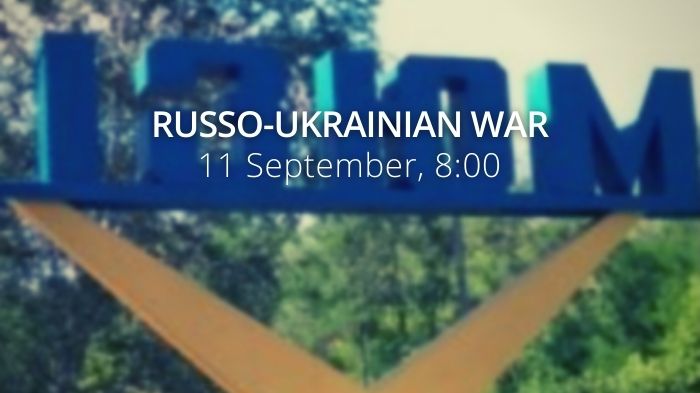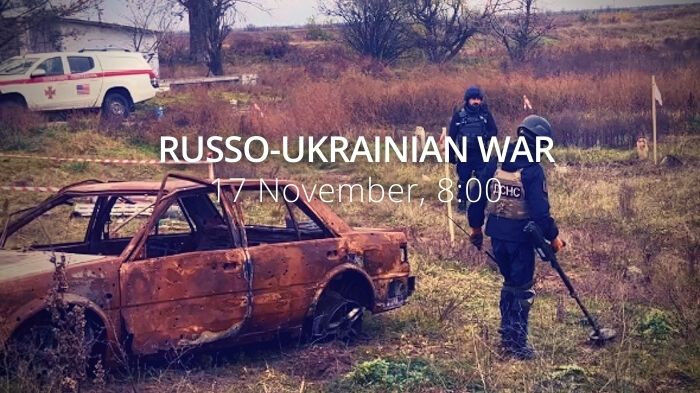Russian forces executed captured Ukrainian soldier after he said “Slava Ukrayini.” Bakhmut is more of a symbolic value than operational. Ukraine’s top generals in favor of continuing Bakhmut defense – President’s Office.
https://twitter.com/EuromaidanPress/status/1632914460712271874
Daily overview — Summary report, March 7
A map of the approximate situation on the ground in Ukraine as of 00:00 UTC 07/03/23. pic.twitter.com/WGDYCiOT75
— War Mapper (@War_Mapper) March 7, 2023
The General Staff’s operational update regarding the Russian invasion as of 18.00 pm, March 7, 2023 is in the dropdown menu below:
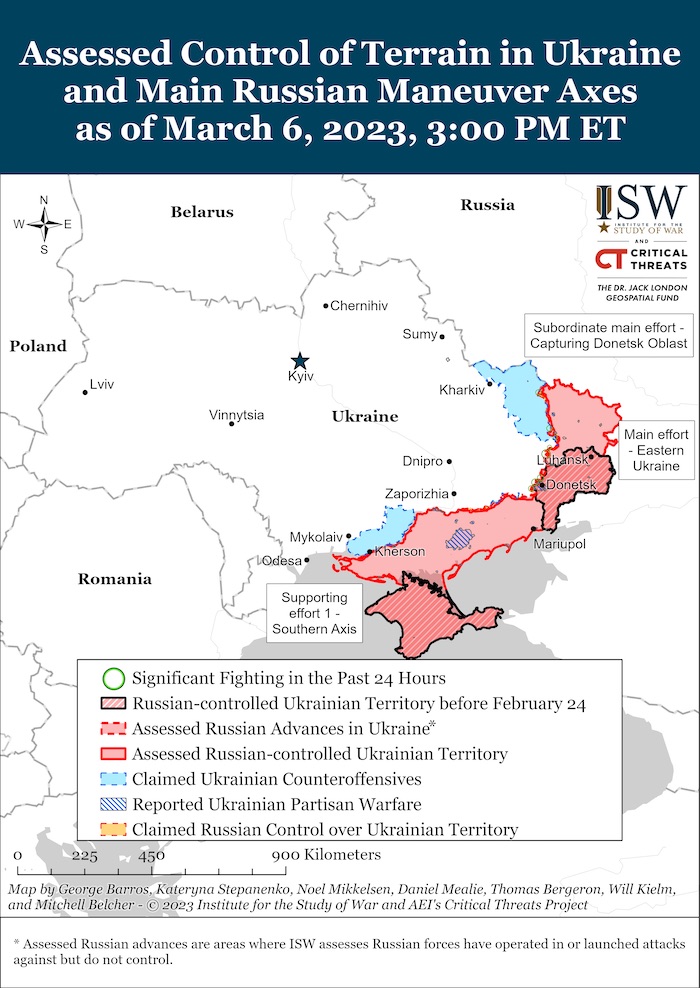
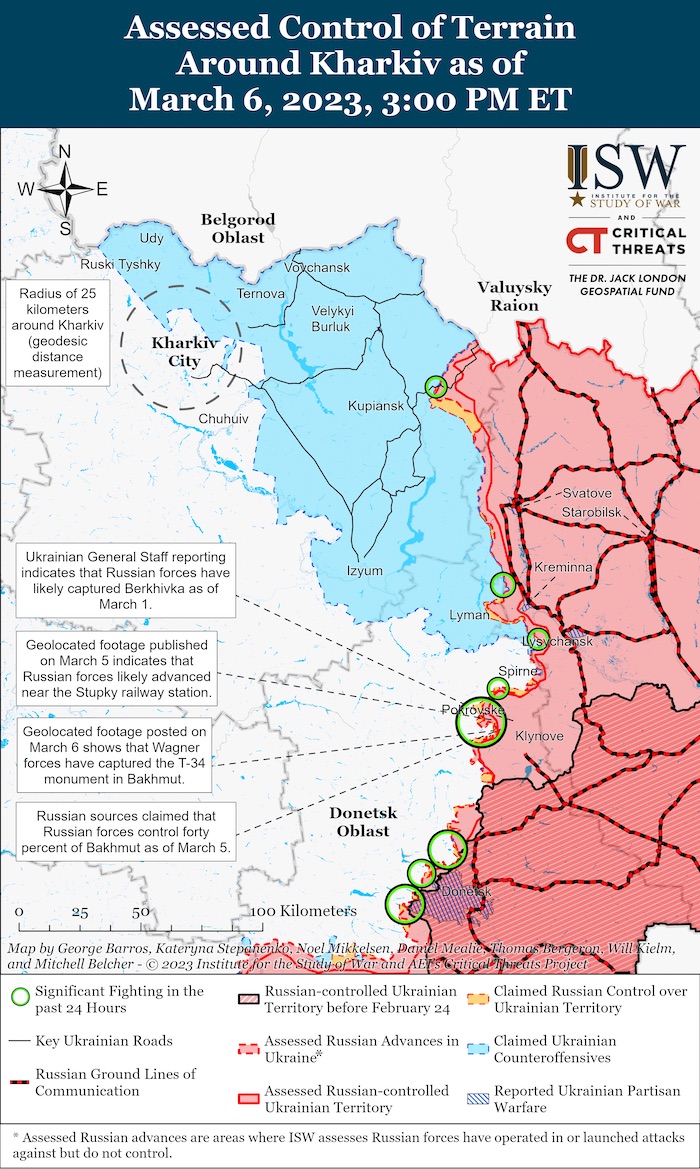
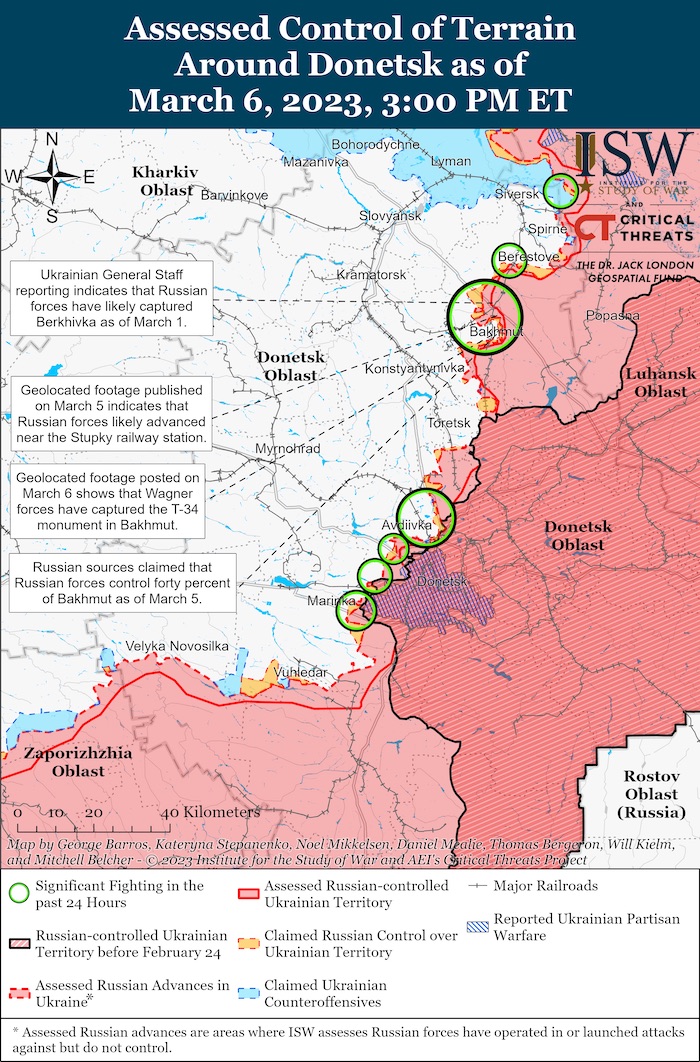
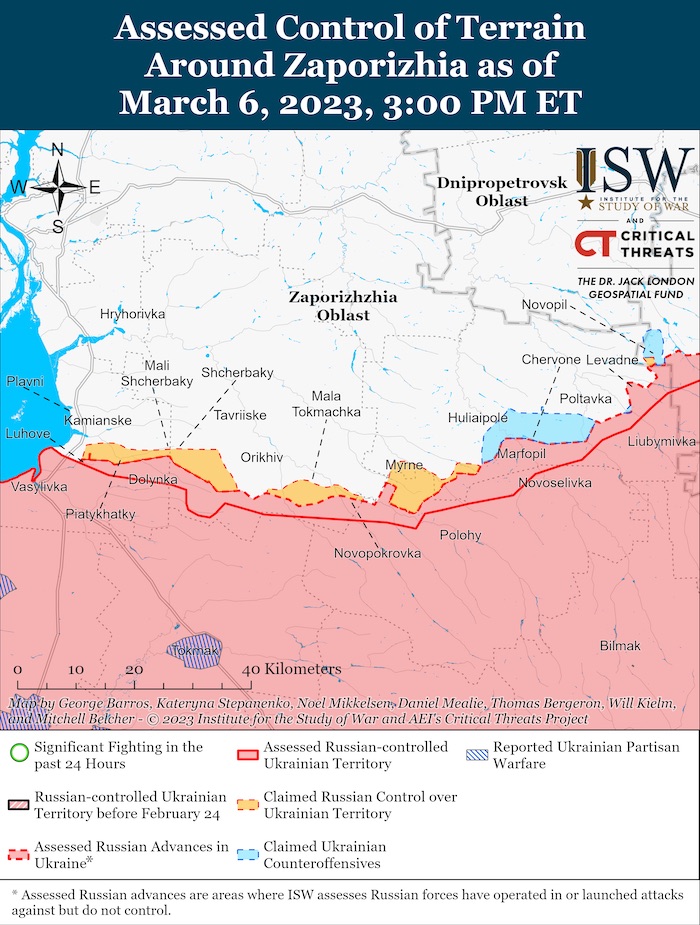
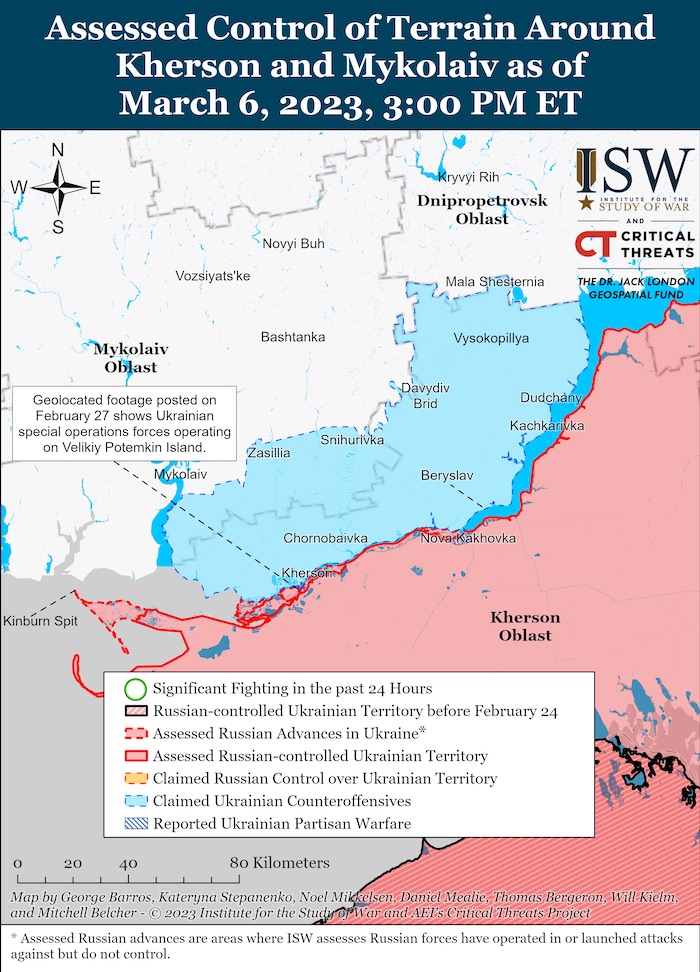
Military Updates
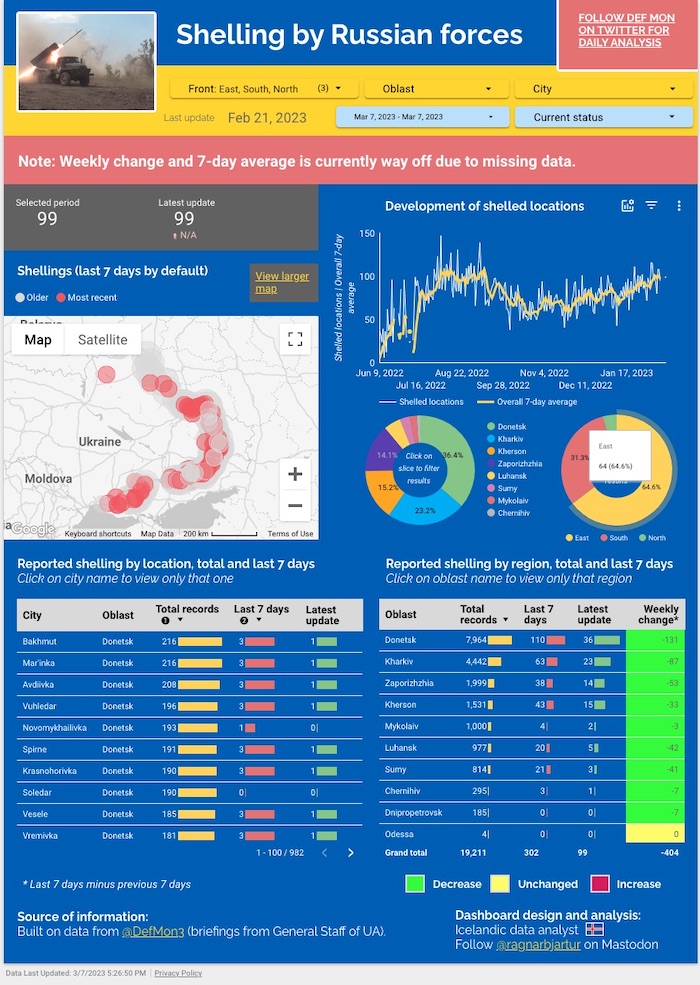
Ukraine forces destroyed 13 of 15 Shahed drones Russia launched at night. The Air Force of Ukraine shot down 13 of the 15 Shahed kamikaze drones that the Russians launched over Ukraine on the night of March 6, Air Force spokesman Yuriy Ihnat reported on the air of the national news marathon. 13 Iranian drones were destroyed by anti-aircraft defense and various fire means, Ihnat added. He urged the residents of Ukraine not to ignore air alarms.
Ukraine’s ground forces commander visited Bakhmut for the third time in two weeks, said battles reached the highest level of tension. The commander of the Ground Forces of Ukraine, Colonel-General Oleksandr Syrskyi, visited Bakhmut on 5 March 2023. This is already his third visit to the city after previous visits on March 3 and February 25. Ukrainian forces have been defending the almost encircled city for a month, while the general fighting for Bakhmut has lasted since last autumn.
Ukraine’s ground forces commander Syrskyi visited Bakhmut for the 3rd time in 2 weeks
He said battles reached the highest tension. According to official report, Zelenskyy and military leadership decided "to continue defense operation in Bakhmut." https://t.co/0KIBYM5mZ9 pic.twitter.com/mSDeqxQjQ6
— Euromaidan Press (@EuromaidanPress) March 6, 2023
Ukraine’s top generals in favor of continuing Bakhmut defense – President’s Office. On 6 March, Ukrainian President Volodymyr Zelenskyy held a scheduled meeting of the Staff of the Supreme Commander-in-Chief with army commanders who reported on the situation on the main frontline directions. According to the statement on the meeting published by President’s Office, both the army’s top general, Valeriy Zaluzhnyi, and the ground forces commander, Oleksandr Syrskyi, suggested that Ukrainian forces would continue the defense of Bakhmut, the frontline city in Donetsk Oblast, which has been under the looming threat of encirclement by Russian forces.
According to British Defence Intelligence, (last 48 hours):
Russia replenishes armor losses with 60-year-old tanks, APCs – British intel
- The Ukrainian defence of Bakhmut continues to degrade forces on both sides. Over the weekend, Ukrainian forces likely stabilised their defensive perimeter following previous Russian advances into the north of the town.
- A Russian strike destroyed a bridge over the only paved supply road into Bakhmut still under Ukrainian control around 02 March. Muddy conditions are likely hampering Ukrainian resupply efforts as they increasingly resort to using unpaved tracks.
- Public disagreements between the Wagner Group and Russian Ministry of Defence over the allocation of munitions highlights the difficulty in sustaining the high levels of personnel and ammunition required to advance with their current tactics.
Losses of the Russian army
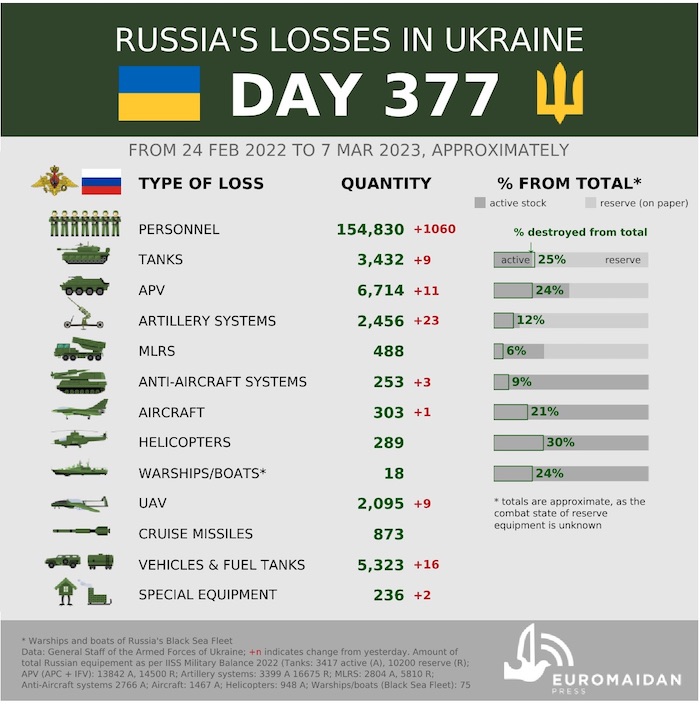
Russia lost five times more soldiers under Bakhmut than Ukraine, NATO estimates. For every Ukrainian soldier killed defending Bakhmut, Russian forces have lost at least five, a NATO official told CNN, adding that this ratio was an informed estimate based on intelligence. The official spoke to CNN on the condition they remain anonymous because they are not allowed to discuss this intelligence. Despite the favorable ratio, they also said Ukraine was suffering significant losses defending the city.
Humanitarian
https://twitter.com/EuromaidanPress/status/1632833187670892544
Kherson patrolmen helped woman in labor to get to the hospital during Russian shelling. In Kherson, during Russian shelling of the city, patrolmen helped a woman in the last month of pregnancy to get to the hospital. In complete darkness, to the sounds of explosions, the crew escorted the car with the woman in labor to the hospital, the National Police of Ukraine reported. As a result of the explosions and stress she experienced, she started having premature contractions. That day, the woman gave birth to a girl weighing 3 kilograms. The next day, the patrol officers visited the new mother to congratulate her on the birth of Mariyka.
Legal
#Ukraine ‘refugee’ from #Kharkiv held prisoner in #Russia #psychiatric hospital for refusing #Russian citizenship #StandWithUkraine #StopRussia #PunitivePsychiatryhttps://t.co/7p6RhoRwym pic.twitter.com/MocdyjGy38
— Euromaidan Press (@EuromaidanPress) March 6, 2023
Russian forces executed captured Ukrainian soldier after he said “Slava Ukrayini” (updating). A video appeared of how captured Ukrainian soldier was executed. He said “Slava Ukrayini” before being shot. The head of Ukraine’s presidential office Andriy Yermak has already reacted to the video, saying all Russian war criminals should face responsibility.
Ukraine finally appointed a director for the Natonal Anti-Corruption Bureau - Semen Kryvonis. However, he's a man with ties to the President's Office and "zero experience" in anti-corruption work, says a key watchdog. https://t.co/C1EsfgVWKF
— Euromaidan Press (@EuromaidanPress) March 6, 2023
Support
Ukrainian Def Min Reznikov asked his EU counterparts to provide Ukraine with 250,000 artillery shells to easy ammo shortage - FThttps://t.co/ZHamkcNbGF
— Euromaidan Press (@EuromaidanPress) March 6, 2023
Ukraine is running low on ammo, asks EU for 250,000 artillery shells a month. In a letter obtained by the Financial Times, Ukrainian Defense Minister Oleksii Reznikov appealed to his counterparts in the EU states on 2 March to provide Ukraine with 250,000 artillery shells a month to ease a critical shortage, due to which Ukraine’s Armed Forces “only firing a fifth of the rounds they could.” Reznikov said Ukraine was firing on average 110,000 155mm-caliber shells a month, a quarter of the amount used by Russia.
New Developments
Group in NATO supportive of giving Ukraine guarantees – Polish Ambassador
Putin’s pal profits from Kyiv mall financing Russian military – journo investigation. The Ministry of Justice of Ukraine has filed a lawsuit with the High Anti-Corruption Court of Ukraine (HACC) seeking sanctions against the Russian owners of the Ocean Plaza shopping center. According to the Ministry of Justice, Rothenberg continues to control two-thirds of the mall shares through nominal Swiss owners. A Russian oligarch and close friend of Putin still owns 67% of the mall’s shares, as reported by Ukrainian Telegraf, citing Trap Agressor’s investigation.
Estonian FM Reinsalu calls for EU to halve the $60 price cap on Russian oil
Tallinn pushes for precendent on confiscating Russian assets.https://t.co/o1ucbJdncQ
— Euromaidan Press (@EuromaidanPress) March 6, 2023
Russian ship loaded with military equipment enters the Black Sea. A Russian cargo ship slipped quietly into the Black Sea with a suspected load of war supplies for Russia’s invasion of Ukraine, Naval News reports. The ship, Sparta IV, was loaded in Syria and sailed with a Russian Navy escort. Although Türkiye closed the waterway between the Mediterranean and the Black Sea to Russian warships, the flow of military supplies continues.
Bakhmut is more of a symbolic value than operational – Austin. US Defense Secretary Lloyd Austin said on Monday that the eastern Ukrainian city of Bakhmut was of more symbolic than operational importance, and its fall would not necessarily mean that Moscow had regained the initiative in the war, Reuters reports. The battle for Bakhmut has raged for seven months. A Russian victory in the city, which had a pre-war population of about 70,000 but has now been blasted to ruins, would give Moscow the first major prize in a costly winter offensive.
As traditional weapons suppliers like the US face wartime production shortages, South Korea has stepped in to fill the gap, while trying not to provoke Moscow.https://t.co/vsmq00tPD6
— Euromaidan Press (@EuromaidanPress) March 6, 2023
Assessment
https://www.understandingwar.org/backgrounder/russian-offensive-campaign-assessment-march-6-2023*
- On the war.
The Institute for the Study of War has made the following assessment as of March 6, 2022:
Ukrainian authorities indicated that Ukraine will continue to defend Bakhmut for now. Ukrainian President Volodymyr Zelensky stated at the end of the day on March 6 that he has ordered reinforcements to Bakhmut.[1] This announcement follows Zelensky’s March 6 meeting with Ukrainian Commander-in-Chief General Valerii Zaluzhnyi and Commander of Ukrainian Ground Forces Colonel General Oleksandr Syrskyi where both commanders recommended the continued defense of Bakhmut and asked Zelensky to strengthen Ukrainian forces in the area.[2] Ukrainian Presidential Advisor Mykhailo Podoliak similarly stated on March 6 that the Ukrainian defense of Bakhmut thus far has “achieved its goals” and been a “great strategic success.”[3] Statements made by Ukrainian officials regarding Bakhmut are likely meant in part to respond to the continued concern expressed by some Americans regarding the costs of Ukraine’s continued defense of Bakhmut. US Secretary of Defense Lloyd Austin stated on March 6 that he would not view a Ukrainian withdrawal from Bakhmut as a “significant strategic setback,” possibly intimating that he favors such a withdrawal.[4]
Bakhmut is not intrinsically significant operationally or strategically as ISW has previously observed. Taking Bakhmut is necessary but not sufficient for further Russian advances in Donetsk Oblast, and Russian forces have already taken such heavy losses fighting for the city that their attack will very likely culminate after they have secured it—if not before. The loss of Bakhmut is not, therefore, of major operational or strategic concern to Ukraine, as Secretary Austin and others have observed.
But Ukraine’s fight for Bakhmut has become strategically significant because of the current composition of Russian forces arrayed in the area. Some Western reports have recently suggested that Ukraine is expending its own elite manpower and scarce equipment on mainly Wagner Group prison recruits who are mere cannon fodder, noting that such an exchange would be to Ukraine’s disadvantage even at high ratios of Russian to Ukrainian losses. That observation is valid in general, although the pool of Russian convict recruits suitable for combat is not limitless and the permanent elimination of tens of thousands of them in Bakhmut means that they will not be available for more important fights.
Russian forces fighting in Bakhmut are now drawn from the elite elements of the Wagner Group and from Russian airborne units as well as from lower-quality troops. Ukrainian intelligence has supported ISW’s assessment that Russian forces near Bakhmut have recently changed tactics and committed higher-quality special forces operators and elements of conventional forces to the fight.[5] ISW has previously reported on the increasing presence of Russian Airborne (VDV) forces around Bakhmut since late December into early January, indicating that conventional Russian troops may be supporting or even supplanting Wagner’s operations around Bakhmut.[6] The Wagner Group is still likely using prisoners to support operations in Bakhmut, albeit to a much more limited extent than in previous months due to massive losses suffered by those recruits in attritional frontal assaults. But Wagner has now also committed its very best soldiers to the fight, and it is they who are being attrited along with the conscripts.
The Battle of Bakhmut may, in fact, severely degrade the Wagner Group’s best forces, depriving Russia of some of its most effective and most difficult-to-replace shock troops. The Wagner attacks already culminated once, causing the Russian Ministry of Defense (MoD) to commit some of its elite airborne troops to the fight. It may well culminate again before taking the city, once more forcing the Russian military to choose between abandoning the effort or throwing more high-quality troops into the battle. The opportunity to damage the Wagner Group’s elite elements, along with other elite units if they are committed, in a defensive urban warfare setting where the attrition gradient strongly favors Ukraine is an attractive one.
Wagner Group financier Yevgeny Prigozhin apparently fears that his forces are being expended in exactly this way. Prigozhin made a number of statements on March 5 and 6 that suggest that he fears that the Russian Ministry of Defense (MoD) is fighting the Battle of Bakhmut to the last Wagner fighter and exposing his forces to destruction. Prigozhin claimed that he wrote a letter to the commander of Russian forces in Ukraine (presumably Chief of the General Staff Army General Valery Gerasimov) with an urgent appeal for the Russian command to allocate ammunition to Wagner but that his representative was denied access to Russian headquarters and could not deliver the appeal.[7] Prigozhin later published a response to the Zelensky-Zaluzhnyi-Syrskyi meeting on March 6 and claimed that Ukraine has formed a number of offensive groups in Donetsk Oblast to “unblock” Wagner’s blockade of Bakhmut and that he has been “raising the alarm” to call for ammunition and reinforcements for Wagner.[8] Prigozhin claimed that if Wagner does not receive needed ammunition and reinforcements and the blockade of Bakhmut breaks, all is essentially lost and that he will stay with Wagner to the end.[9] Prigozhin’s plea to the Russian General Staff and suggestion that he will stay with Wagner until the bitter end suggests that he is working to position himself as the ultimate martyr for the ideological cause that Bakhmut has come to represent in the Russian milblogger information space. More importantly, it shows that he sees his elite forces to be in grave danger.
The severe degradation or destruction of the elite Wagner fighting force would have positive ramifications beyond the battlefield. Prigozhin has ostentatiously ramped up efforts to disseminate Wagner’s militarism and ideology throughout Russia by advertising Wagner’s role in Bakhmut. The Wagner Group has recently opened several recruitment centers at sports clubs throughout Russia, opened a youth branch, and is visiting schoolchildren to lecture them about Wagner’s structure and show them unfiltered combat footage from Ukraine.[10] Wagner’s success in Bakhmut thus far has given Prigozhin a major advantage in the information space, bolstering his reputation and increasing his popularity in a way that will likely have long-term impacts in the Russian domestic sphere. Prigozhin is one of the most extreme of the Russian pro-war nationalists. He is one of the very few with a serious military force loyal to himself. He has even seemed at times a possible threat to Putin or a possible successor. Which may be why Putin is allowing the Russian MoD to hang him out to dry. Badly damaging Prigozhin’s power and reputation within Russia would be an important accomplishment from the standpoint of the long-term prospects for restoring sanity in Russia. That is an aim in America’s interests as well as in Ukraine’s, and it raises the stakes in the Battle of Bakhmut beyond matters of terrain and battlespace geometry.
The Kremlin is returning to its previously unsuccessful volunteer recruitment and crypto-mobilization campaigns to avoid ordering another major involuntary reserve call-up. Russian Telegram channels began advertising for recruitment into existing volunteer battalions after ceasing such recruitment calls in September 2022 at the start of involuntary reserve mobilization.[11] Some local Russian officials are also setting up mobile recruitment centers in order to advertise voluntary military contract service — a phenomenon that ISW observed during the previous volunteer recruitment campaign between late May 2022 and September 2022.[12] Russian officials are even advertising contract service in unusual places: A Moscow-based psychiatrist is reportedly calling on suicidal men to enlist.[13] Russian ultranationalist social media networks are also increasingly advertising recruitment for Wagner Group units across almost 30 Russian cities.[14] Ukrainian officials observed instances of Russian occupation officials registering male teenagers born in 2006 from occupied Luhansk Oblast for military service.[15] The Ukrainian General Staff also reported that military recruitment centers in occupied Donetsk Oblast received instructions to clarify personal credentials of reserve officers under 65 years of age, and soldiers, sergeants, and warrant offices under the age of 50.[16] Russian officials had extensively conducted similar crypto-mobilization in occupied Ukrainian territories throughout the war, especially over the summer.
Such voluntary recruitment drives may also indicate that the Kremlin is running out of combat-ready reserves to continue its offensive operations past the Battle of Bakhmut and its failed offensives around Vuhledar and in Luhansk Oblast. ISW assessed on February 26 that Russian President Vladimir Putin had turned to voluntary recruitment campaigns in late May 2022, when the Russian military began to run out of reserves as it was conducting a costly offensive on the Sievierodonetsk-Lysychansk line — over a month before Russian attack culminated in Luhansk Oblast.[17] Putin later abandoned his country-wide and summer-long volunteer recruitment campaign and ordered an involuntary reservist call-up in response to the sweeping Ukrainian counteroffensive in Kharkiv Oblast in September 2022.[18] The Kremlin may be repeating similar efforts in hopes that such irregular forces will be sufficient to retain Russian initiative on the frontline. Russian veterans and milbloggers, however, observed that Russia will not be able to achieve its objectives of reaching the administrative borders of Donetsk Oblast without the large-scale mobilization of personnel, economy, and industry.[19]
The return of the voluntary recruitment and crypto-mobilization campaigns likely indicates that the Kremlin will not launch another mobilization wave before the summer of 2023 at the earliest because the spring conscription cycle is due to begin on April 1. Western officials previously reported that Putin had been delaying announcing the second mobilization wave since January and was leaning towards conducting “silent mobilization” out of concern for the stability of his regime.[20] The Russian Ministry of Defense (MoD) likely again advised Putin to launch another mobilization over the winter as an involuntary call-up at that time would be less likely to overwhelm already struggling Russian military recruitment centers between bi-annual conscription cycles. ISW had observed numerous indicators that Russia was preparing to execute the second mobilization wave since fall 2022, but Putin passed the mobilization window to avoid further antagonizing Russians who did not support previous involuntary call-ups.[21] The Russian MoD will likely be unable to embark on mobilization processes until after Russia completes its spring conscription cycle given that Russian military recruitment centers appear to have the administrative capacity to prepare and generate roughly 130,000 conscripts per bi-annual cycle.[22] That limitation appears to be relatively inflexible and likely explains why the 300,000 reservists called up in the fall seem to have been trained in batches rather than all at once. It likely also explains why Russian forces are using training areas in Belarus to reconstitute formations damaged in combat. Putin would likely need to delay the spring conscription cycle if he decided to announce mobilization now, likely for longer than the one-month delay in the autumn conscription cycle caused by his September 2022 reserve call-up.[23]
A reportedly captured Russian military manual suggests that Russian forces intend to use the newly created “assault detachment” elements in urban warfare. Ukrainian news outlet Censor.NET originally published the alleged manuals that detail the formation and use of the assault detachment on December 12.[24] ISW previously reported on the “assault detachment” on February 27 and assessed that this newly minted formation is likely an effort to compensate for current combat power limitations by breaking maneuver forces into smaller and more agile structures, thereby partially institutionalizing practices previously used to tactical effect by the Wagner Group in urban combat.[25] A Ukrainian reserve officer amplified documents in the manual on March 5 that recommend assault detachment tactics to be applied in an urban context.[26] The document recommends that Russian forces begin their assaults by targeting the defense‘s frontline with tanks or explosives to make holes in fences and buildings to ensure safe passage of an assault company and suggests how to seize observation points, confuse the enemy, seize multi-story buildings, and take cover. The documents also makes suggestions for Russian forces operating in an assault platoon to break into small groups and clear multi-story and multi-entrance buildings. The Ukrainian reserve officer noted that while the Russian military attempts to create more flexible military formations, instructions are “blindly applied across the battlefield based on a few successful examples.”[27] ISW previously assessed that the documents indicate that the Russian military attempts to simplify combined arms warfare to compensate for the challenges posed by manpower and equipment losses and inexperienced and untrained mobilized personnel.[28] Assault detachments may suffer significant losses in urban warfare given the extensive use of untrained personnel and attritional tactics.
Russian forces utilized a new type of guided aerial bomb against Ukrainian targets amid continued precision missile shortages. Ukrainian news outlet Defense Express reported on March 4 that Russian forces used the UPAB-1500V guided aerial bomb against an unspecified target in Chernihiv Oblast within the past few weeks. Defense Express noted that Russian bomber aircraft can release the bombs up to 40km from the intended target and that the aircraft can maintain a low altitude of 14km, both of which would lessen the risk of Ukrainian air defenses taking out the Russian bombers.[29] Ukrainian Air Force Spokesperson Yuriy Ignat stated that a Russian Su-34 may have been trying to launch a UPAB-1500V when Ukrainian forces shot the jet down.[30] Ignat stated on March 6 that Russian forces will undertake every possible measure to procure more weapons and warned not to underestimate Russia’s ability to procure artillery shells, drones, and missiles for use in Ukraine.[31]
Key Takeaways
- Ukrainian authorities indicated that Ukraine will continue to defend Bakhmut for now.
- Bakhmut is not intrinsically significant operationally or strategically as ISW has previously observed. But Ukraine’s fight for Bakhmut has become strategically significant because of the current composition of Russian forces arrayed in the area. The Battle of Bakhmut may, in fact, severely degrade the Wagner Group’s best forces, depriving Russia of some of its most effective and most difficult-to-replace shock troops.
- Wagner Group head Yevgeny Prigozhin apparently fears that his forces are being expended in exactly this way. The severe degradation or destruction of the elite Wagner fighting force would have positive ramifications beyond the battlefield.
- The Kremlin is returning to its previously unsuccessful volunteer recruitment and crypto-mobilization campaigns to avoid calling the second mobilization wave. The return of the voluntary recruitment and crypto-mobilization campaigns likely indicates that the Kremlin will not launch another mobilization wave at least before the summer 2023 due to spring conscription cycle on April 1.
- A reportedly captured Russian military manual suggests that Russian forces intend to use the newly created “assault detachment” elements in urban warfare.
- Russian forces utilized a new type of guided aerial bomb against Ukrainian targets amid continued precision missile shortages.
- Russian forces continued to conduct ground attacks northwest of Svatove and near Kreminna.
- Russian forces secured territorial gains in Bakhmut but have not yet encircled the city or forced Ukrainian forces to withdraw.
- Russian forces continued to conduct ground attacks near Avdiivka and west of Donetsk City.
- Russian forces continue struggling to maintain fire control over the Dnipro River Delta in Kherson Oblast.
- Russian military command is failing to properly equip its forces despite forces increasingly conducting close combat in Ukraine.
- Ukrainian officials reported on alleged Russian war crimes in Ukraine.


